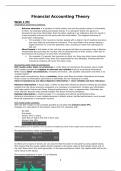Financial Accounting Theory
Week 1 HC:
Information asymmetry problems:
- Adverse selection = a situation in which sellers only sell the product when it is favorable
to them, for example selling overvalued shares. It’s a situation where one party in a
transaction has more information than the other, leading to an imbalance that can result in
a less favorable outcome for the party with less information. This happens because of
asymmetric information.
o For example in the insurance market, people with a higher risk of needing insurance
are more likely to purchase the insurance. This could lead to the insurer setting a
higher premium to cover the potential costs, resulting in lower-risk individuals to
opt out.
- Moral hazard = this refers to the risk that one party will take on excessive risks or behave
irresponsibly because they do not bear the full consequences of their actions, often due to
the presence of insurance or some form of protection.
o For example, if a person has insurance on their car, they may drive more recklessly
than they would if they were fully responsible for any damages, knowing that the
insurance company will cover the repair costs.
Accounting under ideal circumstances:
DCF-model under ideal circumstances = under ideal circumstances the present value model
(DCF-model) provides the highest in relevant and reliable financial accounting information.
When having ideal circumstances, all states are known.; one possible calculation and there is no
‘outside impact’.
Under ideal circumstances, there is certainty; future cash flows and other information are known.
There is also no information asymmetry so estimates are not necessary to make.
Ideal circumstances are about objective information = more reliable and less relevance.
Relevant information = future data. It refers to data that influences decision-making by providing
insights into the future economic prospects of a company or investment; includes any information
that helps predict future cash flows, financial performance, risks, or opportunities. Estimates are
more relevant because they provide insights into future economic prospects.
Reliable information = historical data. It is complete and without (un)intentional bias.
Historical information is more reliable because it reflects actual, verified performance, such as past
financial statements or transaction records.
DCF-model under certainty:
With the DCF-model it is for example possible to calculate the present value (PV).
Example of a calculation of the present value (PV) of a company with:
- No debt.
- One asset.
- Asset’s life is 2 years.
- Cash flow of 150 at the end of each year.
- Interest rate 10%.
-
!When getting such a question, first calculate the beginning value of the capital asset (calculation above).
The opening balance sheet is as followed:
As there are no loans or bonds, we can assume that the asset is fully paid by using capital stocks.
This means that the issued capital stocks(=equity) is the same value as the present value at 0 of
the cash flows which the asset generates. In the opening balance sheet, the capital asset will be the
same value as the equity.
The income statement of year 1 is as followed:
1
,The depreciation of an asset in a year = the asset value on the balance sheet - the
fractions(=breuken) of the existing years.
!De macht die bij de breuken van de existing years hoort moet met -1 naar beneden. Voor de berekening van de
afschrijving in jaar 1 is er dus al een jaar voorbij, waardoor breuk 2 niet meer een macht van 2 heeft, maar een
macht van 1, omdat jaar 2 dus één jaar dichterbij is (zie vraag 15a).
For example, in year 1 the depreciation is the asset value on the balance (260,33) minus the fraction of year 2,
with an equation of 1 instead of 2; 136,36. With this we can calculate the depreciation in year 1.
The value of the assets are all the fractions that are left, so in this example there is after year 1
just one year left so only one fraction:
Asset value = starting value (of that year) – depreciation.
The balance sheet end of year 1 is as followed:
As just explained above, when only paid with capital stocks, the opening value at the credit side is
the same as the opening value of the capital asset. The value of the capital stock remains the same
in every year (as long as nothing happens with the stocks).
When also paid with for example bonds or obligations, the calculation will be different (see later
example).
When calculating the cash value, look at REAL expenses and REAL revenue in that specific year.
For example:
Cash = starting value cash (on the old balance sheet) + extra received cash flow + interest
and dividends received – interest and dividends paid.
Most of the time, interest will be received over cash in the bank; for example in year 2, the
company will receive 10% interest over their 150 cash from year 1. Interest received will be 15 in
that case.
Retained income = one thing which also categorizes under retained income is net income; for
example:
Retained income = value last year + net income – dividends paid.
Net income = calculated by using the accretion of discount method; we take the present value of
the balance sheet at the beginning of the year * the discount rate.
In this example, we take the present value of the balance sheet at the beginning of the year ->
260,33 * 10% = 26,03.
For the balance sheet at the end of year 2, we take the present value of the balance sheet at the
beginning of year 2 (=the same as the balance sheet at the end of year 1).
Arbitrage principal/argument = the buyers and sellers have agreed that this price is the market
value, which means that they are both willing to pay and receive this amount of money for the
asset.
Book value of the asset = market value = present value.
Valuation:
Fair value accounting = measures assets and liabilities at their current market price or the price
that would be received if it was sold right now.
If markets function effectively, fair value accounting provides the best estimate for future prices.
Requiring fair value accounting will lead to increased relevance. By requiring fair value accounting,
the relationship between current financial statement information and future firm performance is
improved, since current values are the best predictors of future values. It can also enhance
transparency, leading to higher earnings quality and lower estimation risk for investors. This
increases the main diagonal probabilities of the information system.
2
, If market prices on efficient markets are available for fair-valued assets, reliability should not
decrease, and may even increase; everything is known which means that estimates are certain.
However, if market values are not available, the possibility of error and manager bias reduces
reliability. The main diagonal probabilities will decrease accordingly.
Using fair value accounting on all assets and liabilities proposes limits on the use of fair value
accounting. Net income calculated this way would not provide any new information to the market.
In efficient markets, share prices already reflect all available information. If markets are inefficient
and shares are mispriced, using this method would likely just continue the mispricing without
adding value.
Under real-world conditions, market values provide only a partial way to implement fair value
accounting, because not all assets and liabilities have active markets, making it hard to apply fair
value accounting consistently. This lack of market data complicates the process and can lower the
reliability of fair value estimates. When reliable market prices are available, fair value accounting
strikes a good balance between relevance and reliability. Scott refers to this as an "indirect
approach to estimating real value”.
So, fair value is the price an asset would fetch in an open market between willing buyers and
sellers, reflecting current market conditions. It represents what a buyer would realistically pay for
the asset right now.
Value in use focuses on the present value of the future cash flows that an asset is expected to
generate during its useful life. It focuses on the economic benefit the asset provides, rather than its
market price.
Between these two, fair value offers investors more reliable information, because this value is
determined by more market participants in a well-regulated market. Value in use also determines
estimates; lowering reliability.
Present-value based accounting = focuses on estimating the current value of future cash flows,
using a discount rate to account for the time value of money.
Uncertainty is a major issue under real conditions. Various external factors create many possible
calculations and outcomes, which lowers reliability. The main challenge is accurately estimating
future cash flows. These estimates can easily be wrong or biased, reducing their reliability.
Still, low reliability does not mean present value-based accounting is not useful. Present value
estimates, though less reliable, are highly relevant and provide valuable information for decision-
making.
Alternative presentation of the income statement:
This alternative presentation is made by making use of the accretion of discount method. This
method means that:
Net income = PV 0 (SE 0) * discount rate.
!Dividends should not be made visible in the income statement! They are only important for the calculation of
cash and retained earnings.
DCF-model under certainty with the issuance of bonds and the rest with common shares (question
16a):
Salvage value(=restwaarde) = salvage value should be added at the last fraction(=breuk) and
should be made present.
If the questions says, “asset is acquired for $2.800” then this means that the beginning value of the
asset is $2.800.
Due to the issuance of bonds, cash value will be influenced by ‘interest paid’, which is coupon
bond * bond value.
3






